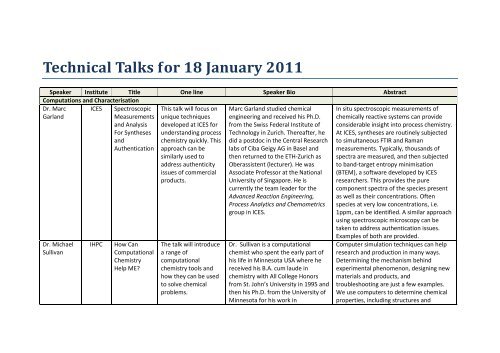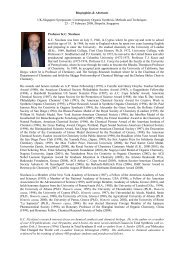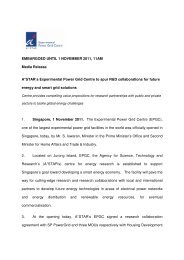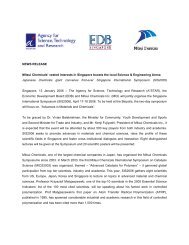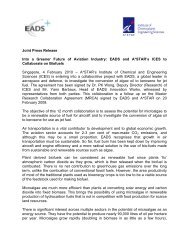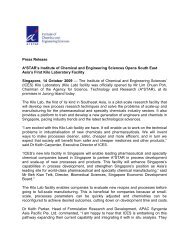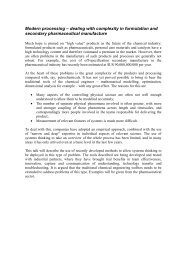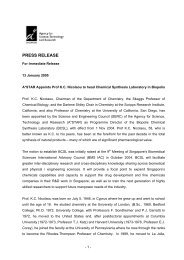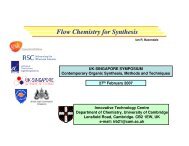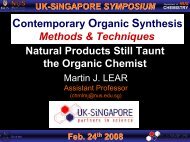here - Institute of Chemical & Engineering Sciences - A*Star
here - Institute of Chemical & Engineering Sciences - A*Star
here - Institute of Chemical & Engineering Sciences - A*Star
Create successful ePaper yourself
Turn your PDF publications into a flip-book with our unique Google optimized e-Paper software.
Technical Talks for 18 January 2011<br />
Speaker <strong>Institute</strong> Title One line Speaker Bio Abstract<br />
Computations and Characterisation<br />
Dr. Marc ICES<br />
Garland<br />
Dr. Michael<br />
Sullivan<br />
IHPC<br />
Spectroscopic<br />
Measurements<br />
and Analysis<br />
For Syntheses<br />
and<br />
Authentication<br />
How Can<br />
Computational<br />
Chemistry<br />
Help ME?<br />
This talk will focus on<br />
unique techniques<br />
developed at ICES for<br />
understanding process<br />
chemistry quickly. This<br />
approach can be<br />
similarly used to<br />
address authenticity<br />
issues <strong>of</strong> commercial<br />
products.<br />
The talk will introduce<br />
a range <strong>of</strong><br />
computational<br />
chemistry tools and<br />
how they can be used<br />
to solve chemical<br />
problems.<br />
Marc Garland studied chemical<br />
engineering and received his Ph.D.<br />
from the Swiss Federal <strong>Institute</strong> <strong>of</strong><br />
Technology in Zurich. T<strong>here</strong>after, he<br />
did a postdoc in the Central Research<br />
labs <strong>of</strong> Ciba Geigy AG in Basel and<br />
then returned to the ETH-Zurich as<br />
Oberassistent (lecturer). He was<br />
Associate Pr<strong>of</strong>essor at the National<br />
University <strong>of</strong> Singapore. He is<br />
currently the team leader for the<br />
Advanced Reaction <strong>Engineering</strong>,<br />
Process Analytics and Chemometrics<br />
group in ICES.<br />
Dr. Sullivan is a computational<br />
chemist who spent the early part <strong>of</strong><br />
his life in Minnesota USA w<strong>here</strong> he<br />
received his B.A. cum laude in<br />
chemistry with All College Honors<br />
from St. John’s University in 1995 and<br />
then his Ph.D. from the University <strong>of</strong><br />
Minnesota for his work in<br />
In situ spectroscopic measurements <strong>of</strong><br />
chemically reactive systems can provide<br />
considerable insight into process chemistry.<br />
At ICES, syntheses are routinely subjected<br />
to simultaneous FTIR and Raman<br />
measurements. Typically, thousands <strong>of</strong><br />
spectra are measured, and then subjected<br />
to band-target entropy minimisation<br />
(BTEM), a s<strong>of</strong>tware developed by ICES<br />
researchers. This provides the pure<br />
component spectra <strong>of</strong> the species present<br />
as well as their concentrations. Often<br />
species at very low concentrations, i.e.<br />
1ppm, can be identified. A similar approach<br />
using spectroscopic microscopy can be<br />
taken to address authentication issues.<br />
Examples <strong>of</strong> both are provided.<br />
Computer simulation techniques can help<br />
research and production in many ways.<br />
Determining the mechanism behind<br />
experimental phenomenon, designing new<br />
materials and products, and<br />
troubleshooting are just a few examples.<br />
We use computers to determine chemical<br />
properties, including structures and


